Mother Teresa was born in Albania as Agnes Gonxha Bojaxhiu. When just eighteen
years old, she attended the religious Order called 'Our Lady of Loreto' in
Ireland. 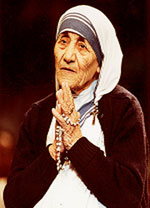 She received her spiritual training in Ireland and Darjeeling, India.
It was in 1931, that the Mother took the name of Teresa from the French nun Th??e Martin, who was canonized in 1927 with the title St. Th??e of Lisieux.
In 1937, Mother Teresa took her vows. She taught for 20 years in Saint Mary's
High School in Calcutta, India.
She received her spiritual training in Ireland and Darjeeling, India.
It was in 1931, that the Mother took the name of Teresa from the French nun Th??e Martin, who was canonized in 1927 with the title St. Th??e of Lisieux.
In 1937, Mother Teresa took her vows. She taught for 20 years in Saint Mary's
High School in Calcutta, India.
The mother was utterly moved by the poverty, suffering and misery of a large
number of people in India. She decided to dedicate her whole life for the
welfare of the poor and took Indian citizenship in 1948. The same year, Pope
Pious XII granted her permission to leave her duties. Mother Teresa became an
independent nun. She began to share her life with the poor, the sick and the
hungry of Calcutta. She started to teach the children of the streets how to read
and write. She established a congregation called the Missionaries of Charity - a
charitable organization which was to be the centre of all her activities with
its branches spread in many parts of the country.
In 1950, Mother also began to care for lepers. She set up a care centre for the patients of leprosy. In 1965, Pope Paul VI put the Missionaries of Charity under his protection and gave Mother the permission to expand her Order to other countries. Branches of the organization opened almost everywhere around the world to assist lepers, the elderly, the blind, and people living with AIDS. Mother also opened schools and homes for the poor and abandoned children. Her vocation was a message of love. Her work demonstrates that a true conviction is always accompanied by action and that love in action is service.
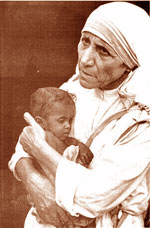 Mother Teresa's efforts and her dedication were recognized all over the world.
The Nobel Peace Prize that was conferred to her in 1979 put a seal of
recognition on her sacrifice and achievements. Despite having reservations, the
Mother accepted it on behalf of the "poorest of the poor".
Mother Teresa's efforts and her dedication were recognized all over the world.
The Nobel Peace Prize that was conferred to her in 1979 put a seal of
recognition on her sacrifice and achievements. Despite having reservations, the
Mother accepted it on behalf of the "poorest of the poor".
In August, 1997 she ended her services and set out on her journey towards
heaven. The cruel hands of destiny snatched the angel of love from us. The
people of Calcutta and the world over bid her a teary farewell. The Government
of India payed adequate respects to her with a solemn funeral march complete
with a guard of honour.
Although Mother Teresa is not amongst us, her sacrifice and dedication has set a
great example for others to follow. The great job that she did will always be
remembered by all of us.
Mother Teresa was beatified by Pope John Paul II on October 19, 2003.
How can we forget to mention about Anna Jarvis - the woman behind the official establishment of Mother's Day?
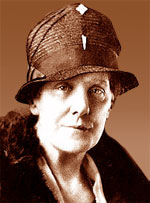 Anna spent her childhood at Grafton. She attended college in Virginia and then
returned to Grafton to become a teacher. From her childhood she remembered how
important the cause of establishing a day of recognition for mothers was to her
own mother.
Anna spent her childhood at Grafton. She attended college in Virginia and then
returned to Grafton to become a teacher. From her childhood she remembered how
important the cause of establishing a day of recognition for mothers was to her
own mother.
The women of the Jarvis family possessed an obsession towards activism which was
hardly seen in the women of their times in the 1900's.At a time when most women
devoted their time solely on their family and homes, the Jarvis women were
working to ensure that these homemakers were recognized and honored in their
work as mothers. Anna's mother, Mrs. Ann Marie Reeves Jarvis helped develop the
"Mothers Friendship Day" to assist in the healing of the nation after the Civil
War. After the death of her mother, Anna Jarvis decided to dedicate her life to
her mother's cause and to establish Mother's Day to "honor mothers, living and
dead."
It is said that Anna and her mother had a quarrel some days before the latter's death. To Anna's intense grief, Mrs. Ann died before the two could reconcile. It is also said that she swore at her mother's gravesite in 1905 to dedicate her life to her mother's project, and establish a Mother's Day to honor mothers, living and dead.
Thus, the tradition of Mother's Day was established by the determination of a loving daughter. Miss Jarvis worked industriously, writing innumerable letters to influential people and distributing pamphlets to gain recognition for motherhood. It was due to Anna's tireless work and efforts that the first Mother's Day service was held on May 10, 1907 (though some sources state 1908), at her mother's church, St. Andrew's Methodist Episcopal Church in Grafton. She passed out more than 500 white carnations, one for each mother in the congregation. The white carnation was her most favorite because it represented the purity of a mother's heart. A white carnation was worn to honor deceased mothers and a red one to honor a living mother.
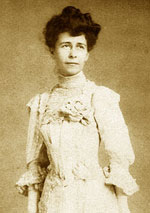 The cause
received a great impetus when John Wanamaker, a great merchant and
philanthropist from Philadelphia joined Anna's campaign. Anna's efforts started
bearing fruit and by 1912 West Virginia became the first state to adopt an
official Mother's Day, and finally by 1914, the Congress passed a joint
resolution, signed by President Woodrow Wilson, to establish Mother's Day.
The cause
received a great impetus when John Wanamaker, a great merchant and
philanthropist from Philadelphia joined Anna's campaign. Anna's efforts started
bearing fruit and by 1912 West Virginia became the first state to adopt an
official Mother's Day, and finally by 1914, the Congress passed a joint
resolution, signed by President Woodrow Wilson, to establish Mother's Day.
Despite all the joy surrounding her successful campaign, Miss Jarvis was not
totally happy. She was, in fact, greatly concerned with the steadily increasing
commercialization of Mother's Day and opposed the selling of flowers and the use
of greeting cards. She felt that her holiday, which was meant to be a "noble and
true" celebration, had been exploited for profit. Miss Jarvis was concerned with
reform, not revenue.
The Mother's Day movement was a celebration of the importance of women and their
work inside the home, as mothers. The very involvement of Anna Jarvis and other
activists brought the role of mothers and homemakers into the eyes of the
public- giving it positive exposure, acknowledgment, and public admiration.
The resolve and resilience of Anna Jarvis and her mother towards their causes and beliefs made them a hero. She is a true hero not only because of her devotion, love, and loyalty as daughter but also as her dedication as a sibling, caring for her unsound sister. It is a great irony that the women who worked tirelessly for the cause of all mothers couldn't become a mother herself. But through her work, she earned the title of the "Mother of Mother's Day,"- a title as grand as her beautiful cause.
When one talks about famous mothers, the name of Raja Weksler immediately comes to the mind. An woman of substance, Raja Weksler stands as a symbol of courage and a perfect example of motherhood.
It was World War II, one of the blackest periods in the history of mankind. Raja lived in the city of Vilnius, Lithuania. She had a beautiful daughter, Susie Weksler who was only eight when Hitler's forces invaded Vilinius. As it was war time, people were taken as prisoners in the Nazi camps; tortured and deprived of the basic needs of food and clothing. Raja, with her daughter, managed to stay out of the German soldiers' clutches. She managed to save not only her own daughter, but also many other people during the holocaust. When the prisoners in the Nazi prison camps were starving and had hardly any clothes, she gave them most of her food to eat and brought them clothes to wear. Along with her daughter she went about giving food and distributing clothes to people, so that they can bedeck their bodies.
Seeing that Raja and her daughter were extending help to people, they were sent to the concentration camp, where they were ill treated. They were starved, beaten and made to do hard work. Raja Weksler was forced to wear David's star on all of her clothes. Raja and Susie were forced by the Nazis to move to ghettos where they were treated like dogs. Raja and her family faced the hunger and fear of the Vilnius ghetto. They had almost no human rights. The Nazis held several 'actions' in which they had to meet quotas of how many prisoners they killed or sent to concentration camps.
Raja created a hiding spot in one of the houses, where she and some other people hid during one of the actions. Raja and Susie were forced by Nazis to go to a cemetery where they had to spend the night. The next day, the Nazis made them go through long lines. After first being put in the 'weak person' group, which they knew they would be sent to die, they finally got into the strong group which was headed for a concentration camp where there was at least hope for the future.
Raja and 11-year-old Susie were shipped to concentration camps. There were 'actions' there also. They were starved, beaten, and made to stand outside in the freezing cold or the heat for hours waiting for the 'at-ease' signal. They survived not only the hard labor but also serious illness. All that time, Raja focused on taking care of Susie, who miraculously was still with her. Raja was transferred to another camp called Auchwitz.
Raja and Susie were forced to march in the death march in the winter for a long
time and almost died. They almost died countless times.
The war finally ended in 1945. If it weren't for her mother, Susie Weksler would
have died in the very beginning before the war even started. Susie lived only
because of the ingenuity and courage of her mother. It was her mother who
disguised Susie as an adult to fool the camp guards; who fed her body and soul
through gruesome conditions in three concentration camps; who showed her the
power of the human spirit to survive. Had her mother not been there to take care
of her, Susie would have died long ago.
Raja Weksler truly proved to be a guardian angel for her daughter, Susie. Her life had been a tough one, in which she had to face many hurdles. But she didn't give up and fought till the very end, saving in the process not only the life of her own daughter, but also of many other children. Her very name stands as the epitome of a perfect mother.
On 22nd December 1853, a saintly soul was born in a poor Brahmin
family in Jayrambati, a village adjoining Kamarpukur in West Bengal.
Little did the world know that this little baby girl would one day
become Sri Sarada Devi, the wife and spiritual consort of Sri
Ramakrishna, one of the greatest spiritual souls the world has ever
beheld.
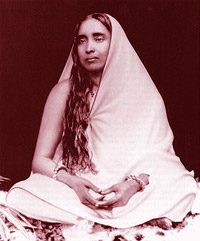 When only about six years old, she was married off (as was
the custom prevalent in India in those days) to Sri Ramakrishna.
However, she continued to live with her parents after marriage,
while Sri Ramakrishna lived a God-intoxicated life at Dakshineshwar.
When she turned 18, Sarada went to her husband who received her with
great affection, and allowed her to stay with him. But they lived
pure lives and Sri Ramkrishna is believed to have obtained her
wife's permission in following his spiritual path and staying away
from a sensual domestic life. Sri Sarada Devi smilingly encouraged
her husband and remained a virgin nun. Sri Ramakrishna accepted her
as his devoted wife and disciple and taught her how to lead a
spiritual life while discharging her household duties. He aroused
the universal Motherhood latent in her and taught her to look upon
his disciples as her own children. When Sri Ramakrishna passed away
in 1886, Sarada Devi went to Kamarpukur to live in seclusion. But
the disciples of Sri Ramakrishna brought her to Kolkata and many
spiritual seekers became her disciple. Sarada Devi made no
distinction between them and accepted all as her children
irrespective of caste, religion or race. Even those who had led
sinful lives were not turned away. She demonstrated her progressive
outlook in a conservative society when she accepted the Western
women disciples of Swami Vivekananda, one of her husband's greatest
disciples. All through her life, this divine lady lived like a
simple village mother, washing clothes, sweeping the floor, bringing
water from the pond, dressing vegetables, cooking and serving food.
In her own words, she lived to "manifest that Divine Motherhood in
the world" that Sri Ramakrishna had, the "maternal attitude (matri-bhava)"
that he possessed. For thousands of people including Swami
Vivekananda, she was the ideal woman and the "Holy Mother".
When only about six years old, she was married off (as was
the custom prevalent in India in those days) to Sri Ramakrishna.
However, she continued to live with her parents after marriage,
while Sri Ramakrishna lived a God-intoxicated life at Dakshineshwar.
When she turned 18, Sarada went to her husband who received her with
great affection, and allowed her to stay with him. But they lived
pure lives and Sri Ramkrishna is believed to have obtained her
wife's permission in following his spiritual path and staying away
from a sensual domestic life. Sri Sarada Devi smilingly encouraged
her husband and remained a virgin nun. Sri Ramakrishna accepted her
as his devoted wife and disciple and taught her how to lead a
spiritual life while discharging her household duties. He aroused
the universal Motherhood latent in her and taught her to look upon
his disciples as her own children. When Sri Ramakrishna passed away
in 1886, Sarada Devi went to Kamarpukur to live in seclusion. But
the disciples of Sri Ramakrishna brought her to Kolkata and many
spiritual seekers became her disciple. Sarada Devi made no
distinction between them and accepted all as her children
irrespective of caste, religion or race. Even those who had led
sinful lives were not turned away. She demonstrated her progressive
outlook in a conservative society when she accepted the Western
women disciples of Swami Vivekananda, one of her husband's greatest
disciples. All through her life, this divine lady lived like a
simple village mother, washing clothes, sweeping the floor, bringing
water from the pond, dressing vegetables, cooking and serving food.
In her own words, she lived to "manifest that Divine Motherhood in
the world" that Sri Ramakrishna had, the "maternal attitude (matri-bhava)"
that he possessed. For thousands of people including Swami
Vivekananda, she was the ideal woman and the "Holy Mother".
On 21 July 1920, the Holy mother left her mortal coils to be in
unison with the great divinity. But even about 100 years later, she
remains ever so bright in our hearts and her peaceful image
continues to be venerated in many Indian homes.